
Rare earth magnets 2!
Review date: 20 January 2004.Last modified 03-Dec-2011.
Twenty years ago, neodymium-iron-boron (NIB) magnets were very exotic technology indeed. They didn't hit the retail market at all until the end of 1984, and then they were seriously expensive for some time.
That was then, this is now. NIB magnets are all over the place now, in everything from electric motors to construction toys large and small
Today, you can get "surplus" NIB magnets from umpteen dealers at prices from well under one US dollar each (for button-sized ones) to $US10 or $US20 for magnets big enough to hurt you badly.
The cheapest NIBs out there are likely to be have a low "grade" number - probably something like "N35", versus the higher-than-N40 grade of more expensive magnets.
The grade of a NIB magnet doesn't actually matter much, though. Higher grade magnets can be magnetised more strongly (and probably have been) and are more difficult for another magnetic field to demagnetise. But you can't demagnetise a NIB magnet with anything less than a seriously powerful electromagnet anyway, and the actual strength difference between old-and-busted N30 grade and new-hotness N48 grade, assuming both are magnetised to their maximum strength, is in the vicinity of 25%. The difference between the commonly seen N38 and the less commonly seen N42 is little more than 5%.
So the problem with cheap surplus magnets isn't strength. It's just that they're a bit boring.
Every basic NIB magnet dealer seems to sell the same stuff. Blocks, cylinders, disks and rings, plus odd-shaped magnets scavenged from voice coil hard drives. Old curved voice coil magnets are great for generators and motors, but the regular flat-square-banana type aren't terribly exciting, and that and basic geometric primitives is all you get.
M'verygoodfriends at ForceField, for instance, stock other magnets as well as NIBs and various interesting stuff besides, but their NIB magnet range is pretty geometrically basic.
Engineered Concepts, on the other hand, have the regular shapes, plus all kinds of other weird stuff. Their Web site ain't much to look at yet, but their stock list, and low prices, make up for it. They kindly sent me a selection of their wares.
See what I'm talking about?
The ruler has metric on its top edge and inches on the bottom. This one inch tall, one inch diameter cone magnet costs $US15 (not bad for an N40-grade magnet this big, but shipping's expensive because of the extra packaging needed for the weird shape).
The cone's magnetised top-to-bottom, so you can stick together a matched pair that's magnetised in opposite directions tail to tail. You can also easily damage the magnet if you allow its pointy pole to slam into something; the standard bright nickel plating over the black NIB ceramic isn't tremendously durable, and the shape of the magnet focuses its field at the point in an invitation to damage.
The cone
Like this, for instance.
Align a ring magnet (a 3/4 inch wide, 1/4 inch thick, 3/8th inch internal diameter ring magnet in N45-grade, in this case; price $US6 for four, or half as much for a lower grade version) so that it repels the tip of the cone, then push it down. It'll resist until it passes the tip and then click into place, like this. This feels much the same as forcing a ring magnet onto a rod magnet, but the cone-and-ring combo lets you do a trick.
Push the ring back up with your thumb while holding the cone, and the ring will shoot into the air when it moves back into the net-repulsion zone.
I tried this trick, and it worked perfectly. The ring shot off, bounced off the low ceiling, fell into a pile of random junk and activated a Level Six Cloaking Field. It took half an hour of tidying before I found it again.
For general playing-with-magnets purposes, these discs are a bad choice. They're listed on the Engineered Concepts disc magnets page along with various more normally proportioned models. The 1mm thick, 10mm diameter ones aren't terribly fragile, but there are also 10 and 15mm diameter, 0.5mm thickness discs, which are easy to snap.
If you want a very low profile magnet to stick to some other object, though, these discs are great. They've got plenty of holding power, but you could conceal one in a piece of cardboard. Magicians, ahoy!
On the subject of concealable magnets...
...these suckers, all put together, have maybe half of the volume of a matchstick.
You're looking at 3x1mm and 2x1mm discs, and 1x3mm rods. The sixteen rods, all together, weigh about three-tenths of a gram. One of them still had no trouble lifting a 15.5g nail clipper, though, despite having only a small contact point with the metal.
More tiny magnets, but these ones are high-end N45 grade, and have a specific purpose. They're for, wait for it, people who make their own brushless motors for radio controlled model planes.
Some such motors are built from scratch, but many of them are rebuilt CD-ROM drive motors. You scrap the stock magnets and windings and add your own powerful magnets, chunky wire and brushless speed controller, and presto, you've got a surprisingly powerful motor for a super-lightweight plane.
Back in the land of basic geometry: Three-quarter inch ball magnets, hands, for the merciless pinching of, yours for $US12 for two...
...and little 8mm balls, at two bucks for three.
The big balls have the usual NIB nickel plating, which means they'll wear away their contact points pretty quickly. NIBs have a tendency to wear each other out, and the coatings on many of them aren't very strong.
The little balls are chrome plated, though. Chrome is a lot tougher than nickel, and it makes them much more suitable for making reconfigurable jewellery and other such things - as shown on the Engineered Concepts ball magnet page, and this page too.
Engineered Concepts also sell epoxy coated ball magnets, which should stand up to even rougher treatment. But they're not as pretty.
One 30 by 30 by 4mm square, two half-inch by 2mm squares, none of them terribly expensive.
The peculiar property these magnets have is that you can stick them together north-to-north or south-to-south, after a fashion. One of the small magnets will stick to the big one the wrong way around if you position it in the centre of the big one, rather than in the corners as shown above. And then, as with the cone and ring, nudging the little magnet away from the centre will move it out of the area where the net magnetic flux is reversed, and just like the ring magnet, it'll ping off into an undisclosed location.
Here's something disturbingly prosaic - ceiling hooks.
These hooks are made for use in classrooms and other places that have a suspended ceiling with steel supports, or anywhere else you can find a ferrous plate over your head. You can stick them anywhere else you like, of course, but they won't support much weight if it's not trying to pull them straight off the surface they're stuck to. As wall hooks, they'd be fine for hanging your oven mitts.
A hole in the base of each hook accepts a special installer/remover tool so you don't have to stand on a table to work with the hooks; in the absence of the special tool, a coat-hanger, some tape and a broom handle would do.
The two humble 8mm-wide disc magnets in the base of each hook make it easy to demonstrate how powerful NIBs can be; stuck to a solid piece of steel (the smooth base of a wood file blade), the hooks could hold up to about three kilograms, though they were dodgy enough up around this weight limit that you wouldn't want to bet on more than their 3.5 pound (1.6kg) rated strength. That's about as much as you should hang from a ceiling T-bar anyway.
The strength of the plastic certainly doesn't seem to be limiting the hooks' carrying capacity; they've got that dead-rigid, crunchy fibre-filled polymer feeling. I don't know whether they're actually filled with glass fibre or anything more exotic, because they look as if they might come in handy sometime and so I don't want to saw one in half.
You can get 12 hooks for $US15 (or 60 for $US60 - everything Engineered Concepts sell is cheaper in bulk), and they come packaged in sets of four. The set I got was neatly divided into two with north poles facing out and two with south poles, so they snapped together into two pairs. Which might be useful for something.
A selection of oddities.
Engineered Concepts list their heart, triangle and star shaped magnets on this page; they're all magnetised through their height like practically every plain round or square flat magnet, and thick enough that they're not especially fragile, though the stars could easily lose corners with rough play.
And then, there are the pyramids. Truncated pyramids, actually (or pyramidal frustums, if you want to get technical), and available with in square and triangular versions, magnetised through the height in either direction.
These little N38-grade tackers are cheap - $US15 for ten of the square ones, $US12.50 for ten of the triangular ones - because they're not very big, with bases only 10mm on a side. They illustrate field focussing well, though; the field strength on top of the small end is about 1.2 times the field strength on the bottom.
If you want a more, ah, concrete demonstration...
...this sucker will give it to you. Two inch square base, one inch square top, N45 grade. The top face apparently has a better than 7000 Gauss field on it (I haven't bought or built a gauss meter yet, so I'm taking this on faith). This is approaching the nominal one Tesla (10,000 Gauss) field strength that people quote for NIBs of all types, but which only actually exists inside the magnet. For comparison, your average fridge magnet is likely to manage a few hundred Gauss, at best.
The big pyramid magnets aren't quite on sale at Engineered Concepts yet, though they're mentioned (and stacked!) on the home page.
This two by one inch cylinder magnet's a bit of a ring-in. It didn't come from Engineered Concepts; it came from ForceField, who sell it for $US45.
This is the most monstrous magnet that ForceField sell, but Engineered Concepts have giants of their own, including their biggest ring magnet. And that ain't where it stops. They'll have even larger magnets made to order, if you ask and can demonstrate to them that you have some idea what the heck you're buying.
Large rare earth magnets are useful things, you see. If you need to crush a hand, blind yourself with ceramic fragments or scare the living dung out of a guest, a NIB magnet weighing some single-digit-fraction of a kilogram will get the job done. The five-by-four-by-one-inch giants that top out Engineered Concepts' stock range have to weigh something like two and a half kilos, which makes me glad they're on the other side of the planet from me.
ForceField sent me a pair of the two-by-one inchers. You're not going to see them both in one picture, because I store them separated by several feet and have not yet felt self-destructive enough to bring them together.
If you want magnets to stick things to the fridge or just play with in idle moments, you don't want something this big. One of the big cylinders comfortably stuck a two centimetre thick book to my fridge.
Giant ferrite magnets are a lot safer. If you're careful, you can chip such a magnet off the back of a defunct loudspeaker driver, though they often break when you try. All physically big magnets have a big area around them where they provide a large fraction of their peak magnetic field, and the noticeable field size of a huge ring magnet from the back of a subwoofer is a lot greater than the field from one of these two-inch-diameter NIB cylinders.
Working out the exact strength of a magnetic field at a given point is a bit tricky, but the reason why big NIBs are so much more dangerous than big ferrites is easy enough to grasp. The surface field strength of a big NIB magnet is up there in the same multi-kilogauss range as that of other NIBs, so it pulls really hard when it's close to something it attracts, and can crush you. Also, the larger noticeable-field size of a bigger magnet means it can grab things from further away and throw them at itself faster. The terminal velocity of things headed unexpectedly for a big NIB, or of big NIBs headed unexpectedly for each other, can be alarmingly high. And energy equals 1/2mv^2.
For reference, the big cylinders each weigh about 385 grams (13.6 oz). This is something in the order of 20,000 times as much...
...as one of the super-tiny cylinders.
There are, however, reasons why someone might want a NIB magnet the size of a small fist. You're building a motor or a generator, you're making some other mechanism that needs something stuck to some ferromagnetic other thing with great force, you're fishing for junk in a lake, you're a circus strongman seeking a novel act.
Generally speaking, though, giant NIBs are not a consumer product. If you think you want one, you're probably wrong. If you think you want two, you'd be well advised to store them several feet apart.
Engineered Concepts, on their biggest baddest magnets page, say that some of the very largest slabs are popular among people who believe that magnetic fields have therapeutic benefits. They've also got a "Thoughts on Permanent Magnets and Medicine" page. Regular readers will realise that things like this press my rant button, so here goes.
Magnetic therapy has been a popular idea for some time. For centuries, actually. Despite cavalcades of entertainingly hokey products for the treatment of humans and animals, actual scientific evidence that there's anything to magnetic therapy beyond the placebo effect is scant, at best.
The Engineered Concepts page mentions a University of Tennessee study that found magnets somewhat more effective than placebo, but which had a tiddly little sample size (only 19 people completed the study; 13 dropped out, possibly because they thought they were wasting their time). The study admits right there in its abstract that it's difficult (I'd go so further, and say impossible) to do a proper double-blind study of magnetic therapy without strapping your patients to beds all day. This is because it's easy for a patient to find out whether they've got the real magnets or the placebo, when the things are strapped to their body all day and they're left unsupervised.
There's a rather more upbeat account of this study on a page that Engineered Concepts link to. I'm sure this has nothing at all to do with the fact that it's on a site that sells therapeutic magnets.
The couple of little NIB magnets that site's selling for at least 20 UK pounds, mind you, would cost you a lot less from Engineered Concepts; all you'd miss out on would be the plastic casing. If you want to experiment with magnet therapy, buy your magnets from a place like Engineered Concepts.
Engineered Concepts list three other medical studies - this one, this one and this one. Only the last study is actually relevant to the effects of permanent magnet field strengths, and it concluded that they didn't do anything unless combined with ionising radiation.
The rest of the results were all from Big-Ass Electromagnets™ saturating a considerable volume with a field at least several times as strong as the very small surface field on the top of the big Engineered Concepts pyramid. None of them had a thing to do with any in vivo effect, particularly pain relief, which is what people usually want from magnetic therapy products.
And then the "Thoughts" page leans on Gary Null.
You don't have to be cognitively unusual to think that an allegedly-therapeutic magnetic whatchamacallit eases your back pain, or heals a wound faster, or lets you sleep more soundly, or whatever. You'd be abnormal if the placebo effect didn't work on you, and there are plenty of other possible explanations.
And there's no reason to suppose that strapping magnets to yourself (while also doing what evidence-based medicine suggests you do, if anything) will do you any harm. The only way even the strongest magnetic fields we've managed to create will hurt anyone is if they haul a fire extinguisher across the room and brain someone with it.
But this very fact is actually strong evidence that nothing is going on. There's no real medical intervention in the world that won't do harm when applied incorrectly or excessively, but there are lots of bogus treatments that can't hurt you in any way. Because they don't do anything. And if you try to cure serious diseases with magnets instead of proper medicine, you won't be with us for long.
Oh, and it should also be noted that the big medical manufacturing companies (and the by-no-means small alternative-medical manufacturing companies...) all sell lots of stuff that isn't patented, so the fact that magnetic therapy widgets can't be patented doesn't mean nobody's interested.
Once again, though - if you do want to fool around with magnetic therapy, and even make yourself a mattress pad that won't let you get back up if you lie on it with a screwdriver in your pocket, you can do it with Engineered Concepts magnets for a lot less money than some carpetbagging huckster would charge you.
Overall
Whinging about medical magnet flapdoodle aside, I like Engineered Concepts a lot. Nifty magnets, good pricing, and solid packaging too. My review magnets came with the usual mild steel sheet around the inside of the box, but also with plenty of foam packaging and press-seal bags for the tiny magnets. The bulky packaging does push up shipping fees, but there's nothing that can be done about that; under-packaged NIB magnets are likely to nail themselves to some postal sorting machinery or the inside of a delivery truck and never make it to your door.
NIB magnets are both useful and fun, and they're even quite safe for computer geeks to play with, as long as you don't get them really close to a CRT monitor. Hard drives are quite safe from NIB-strength fields, as I've discussed before (here and here).
So go and buy some. Now would be a good time.
Review magnets kindly supplied by Engineered Concepts.
Enormous scary cylinder magnets kindly supplied by ForceField.
My original NIB magnet review is here.
And then, there's this.

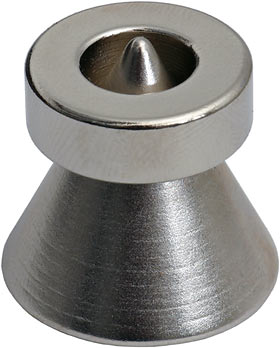
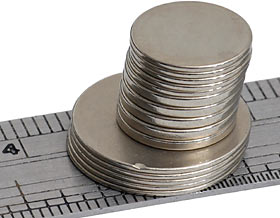
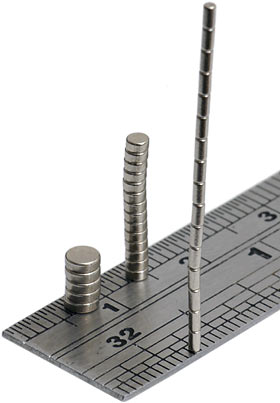
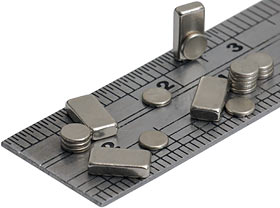
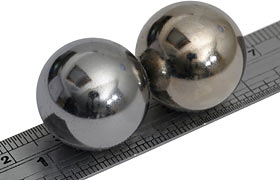
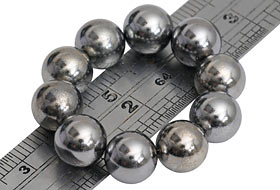
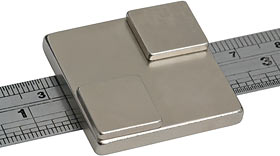
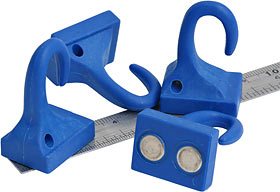
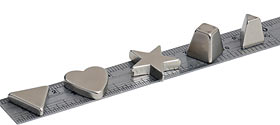
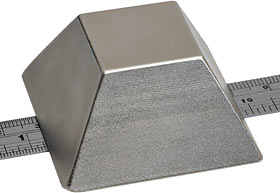
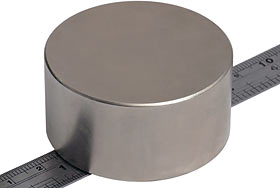
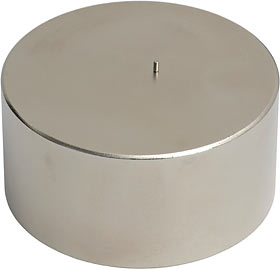
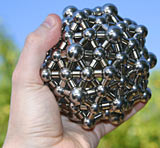

![[SecureWebs]](images/sw.gif)